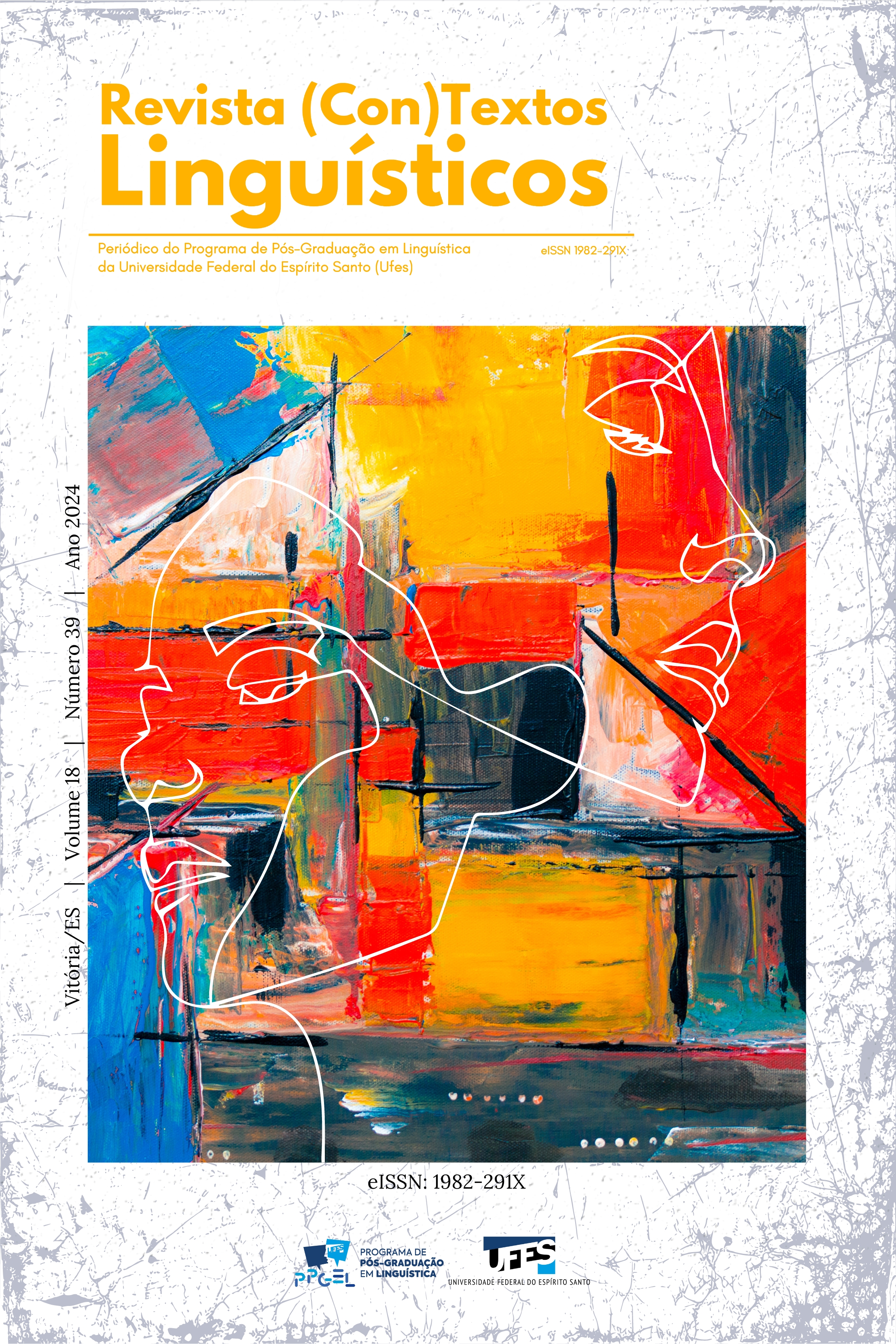Focalização em uma perspectiva tipológica
DOI:
https://doi.org/10.47456/rctl.v18i39.43433Palabras clave:
Focalização, Tipologia linguística, Estrutura informacionalResumen
O presente estudo tem como objetivo apresentar as diversas formas com as quais as línguas naturais focalizam constituintes, notadamente através dos três módulos da gramática responsáveis pela veiculação de sentido: sintaxe, morfologia e prosódia. Para ilustrar nossos argumentos, iremos adotar um pequeno conjunto de 19 línguas, areal e genealogicamente diversificadas. A abordagem adotada no artigo é influenciada pelos pressupostos da Gramática Gerativa (Chomsky, 2015 [1995]; 2001 dentre outros).
Descargas
Referencias
BELLETTI, A. Structures and beyond: The cartography of syntactic structures. In: BELLETTI, A. (ed.). The Cartography of Syntactic Structures. vol. 3. New York: Oxford University Press, 2004. DOI: https://doi.org/10.1353/lan.2008.0047.
BELLETTI, A. Aspects of the Low IP Area. In: RIZZI, L. (ed.). The Structure of IP and CP. The Cartography of Syntactic Structures. vol. 2. New York: Oxford University Press, 2004.
CARNAVAL, M. Foco informacional e foco contrastivo no Português do Brasil: uma abordagem prosódica. 2017. Dissertação (Mestrado em Língua Portuguesa) – Universidade Federal do Rio de Janeiro, Rio de Janeiro, 2017.
CHOMSKY, N. Lectures on government and binding. Dordrecht: Foris, 1981.
CHOMSKY, N. Derivation by phase. In: KENSTOWICZ, M. (ed.). Ken Hale: a life in language. MIT Press, 2001.
CHOMSKY, N. The Minimalist Program. Cambridge: MIT Press, 2015.
CREISSELS, D. Non-canonical applicatives and focalization in Tswana. Proceedings of Syntax of the World’s Languages (SWL 1), Leipzig, 5-8 August 2004, n. August, p. 1–22, 2004.
CRUSCHINA, S. Discourse-Related Features and Functional Projections. Oxford: Oxford University Press, 2011.
EBERHARD, D. M.; SIMONS, G. F.; FENNIG, C. D. Ethnologue: Languages of the World. Twenty-second edition. Disponível em: http://www.ethnologue.com. Acesso em: 31 jul. 2019.
FATAHI, F.; OROJI, M. R.; RAHBARIAN, S. Focalization and Focus Representations in Persian. Frontiers of Language and Teaching, v. 4, n. January, 2013.
FISCHER, K. Cleft sentences: Form, function, and translation. Journal of Germanic Linguistics, v. 21, n. 2, p. 167–191, 2009.
FOMINYAM, H.; ŠIMÍK, R. The morphosyntax of exhaustive focus: A view from Awing (Grassfields Bantu). Natural Language and Linguistic Theory, v. 35. p. 1027–1077, 2017.
GARASSINO, D. Cleft sentences: Italian-English in contrast. Frequency, forms and functions of cleft constructions in Romance and Germanic: contrastive, corpus-based studies. Berlin: De Gruyter Mouton, 2014.
GUITART, J. M. On Spanish cleft sentences. In: KIRSCHNER, C.; DECESARIS, J. (ed.). Studies in Romance Linguistics. Amsterdam/Philadelphia: John Benjamins, 1989. p. 129–137.
GÜLDEMANN, T. The relation between focus and theicity in the Tuu family. In: FIEDLER, I.; SCHWARZ, A. (ed.). The expression of information structure. Amsterdam/Philadelphia: John Benjamins, 2010.
HARTMANN, K. Focus and tone. Acta Linguistica Hungarica, v. 55, n. 3–4, p. 415–426, 2008.
HARTMANN, J. M.; HEGEDŰS, V.; SURÁNYI, B. Pseudoclefts in Hungarian. In: BRANDTLER, J.; MOLNÁR, V.; PLATZACK, C. (ed.). Approaches to Hungarian: papers from the 2011 Lund conference. Amsterdam/Philadelphia: John Benjamins, 2013.
HARTMANN, K.; ZIMMERMANN, M. In place - out of place? Focus strategies in Hausa. In: SCHWABE, K.; WINKLER, S. (ed.). On information structure, meaning and form. Amsterdam/Philadelphia: John Benjamins, 2007.
HEDBERG, N.; FADDEN, L. The information structure of it-clefts, wh-clefts and reverse wh-clefts in English. In: HEDBERG, N.; ZACHARSKI, R. (ed.). The Grammar-Pragmatics Interface: essays in honor of Jeanette K. Gundel. Amsterdam/Philadelphia: John Benjamins, 2007. p. 49–76.
JACKENDOFF, R. S. Semantic Interpretation in Generative Grammar. Cambridge: MIT Press, 1974.
JACOB, P. On the obligatoriness of focus marking. In: FIEDLER, I.; SCHWARZ, A. (ed.). The expression of information structure. Amsterdam/Philadelphia: John Benjamins, 2010.
KANERVA, J. Focusing on phonological phrases in Chicheŵa. In: INKELAS, S.; ZEC, D. (ed.). The Phonology-Syntax Connection. Chicago: Chicago University Press, 1990. p. 145–161.
KISS, K. É. Identificational focus versus information focus. Language, v. 74, n. 2, p. 245–273, 1998.
LAMBRECHT, K. Information structure and sentence form: topic, focus and the mental representations of discourse referents. Cambridge: Cambridge University Press, 1994.
MANETTA, E. Peripheries in Kashmiri and Hindi-Urdu. Amsterdam/Philadelphia: John Benjamins, 2011.
MORAES, J. A. DE; COLAMARCO, M. Você está pedindo ou perguntando? Uma análise entonacional de pedidos e perguntas no português do Brasil. Revista de Estudos da Linguagem, v. 15, n. 2, p. 113–126, 2007.
NESPOR, M.; VOGEL, I. Prosodic phonology: with a new foreword. Studies in Generative Grammar, 1986.
OROJI, M. R.; REZAEI, A. Exploring ‘ ke ’ as a Focus Particle in Persian from both Form and Function Points of View. Australian Journal of Linguistics, v. 33, n. 1, p. 76–84, 2013.
RIALLAND, A.; DOETJES, J.; REBUSCHI, G. What is Focused in C’est XP qui/que Cleft Sentences in French ? Speech Prosody 2002, p. 595–598, 2002.
RIZZI, L. The Fine Structure of the Left Periphery. In: HAEGEMAN, L. (ed.). Elements of Grammar. Amsterdam: Springer Netherlands, 1997. p. 281–337.
RIZZI, L.; BOCCI, G. The left periphery of the clause – Primarily illustrated for Italian. In Blackwell Companion to Syntax, II edition. Oxford: Blackwell Publishers, 2017.
SMIT, N. FYI. Theory and typology of information packaging. Amsterdam: Universiteit van Amsterdam, 2010.
STORTO, L. R. Constituent order and information structure in Karitiana. In: GIJN, R. VAN et al. (ed.). Information structure and reference tracking in complex sentences. Amsterdam/Philadelphia: John Benjamins, 2014.
TRIANON, R. B. E. Focalização in situ no português do Brasil: sintaxe, semântica e prosódia. 2019. Dissertação (Mestrado em Linguística) – Universidade Federal do Rio de Janeiro, Rio de Janeiro, 2019.
TRIANON, R. B. E. Focalização morfológica: uma análise translinguística. 2023. Tese (Doutorado em Linguística) – Universidade Federal do Rio de Janeiro, Rio de Janeiro, 2023.
VELUPILLAI, V. An introduction to linguistic typology. Amsterdam/Philadelphia: John Benjamins, 2012.
Descargas
Publicado
Número
Sección
Licencia
Derechos de autor 2024 Revista (Con)Textos Linguísticos

Esta obra está bajo una licencia internacional Creative Commons Atribución-NoComercial 4.0.
Los autores ceden los derechos de autor del artículo a la editorial de la Revista (Con)Textos Linguísticos (Programa de Posgrado en Lingüística de la Ufes), si el envío es aceptado para publicación. La responsabilidad por el contenido de los artículos recae exclusivamente en sus autores. Queda prohibido el envío total o parcial del texto ya publicado en la revista a cualquier otro periódico.
Este trabajo está bajo Creative Commons Attribution-NonCommercial 4.0 International License.



